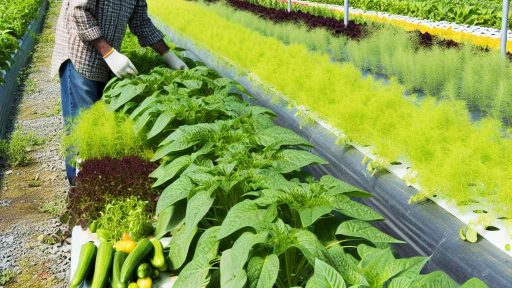Introduction to Crop Rotation and Its Importance for Soil Health
Crop rotation is a vital practice in sustainable agriculture.
This method involves alternating different crops in the same field over time.
By rotating crops, farmers can enhance soil fertility and structure.
Different plants have varying nutrient needs and root structures.
This diversity helps prevent soil depletion and erosion.
Additionally, crop rotation disrupts pest and disease cycles.
Consequently, it reduces the need for chemical pesticides.
Moreover, crop rotation can improve soil organic matter content.
As a result, the soil can store more moisture and nutrients.
Healthy soil leads to better crop yields over the long term.
Farmers should consider their specific conditions when planning rotations.
Each region may require different crop combinations.
Implementing successful crop rotation supports eco-friendly farming practices.
Effective crop rotation promotes long-term soil health and agricultural sustainability.
Understanding Soil Health: Key Indicators and Benefits
Defining Soil Health
Soi health refers to the capacity of soil to function effectively.
Transform Your Agribusiness
Unlock your farm's potential with expert advice tailored to your needs. Get actionable steps that drive real results.
Get StartedIt supports plant growth, water filtration, and nutrient cycling.
Healthy soil fosters a robust ecosystem for microorganisms.
Consequently, soil health is crucial for sustainable agriculture.
Key Indicators of Soil Health
Evaluating soil health involves several key indicators.
Soil structure influences air movement and root growth.
Organic matter levels significantly impact nutrient availability.
Soil pH affects nutrient availability and microbial activity.
Moreover, microbial biomass is essential for organic matter decomposition.
Benefits of Healthy Soil
Maintaining healthy soil offers numerous benefits.
It enhances crop resilience to pests and diseases.
Healthy soil increases nutrient retention and reduces erosion.
Furthermore, it promotes carbon sequestration, combating climate change.
In the long run, healthy soil leads to higher agricultural yields.
Assessing Soil Health
Understanding indicators helps in assessing soil health.
Testing soil regularly provides essential information.
Farmers can examine pH levels, nutrient content, and organic matter.
Selecting the right test methods is vital for accurate results.
Finally, continuous monitoring aids in sustainable management practices.
The Science Behind Crop Rotation: How It Impacts Soil Microbiome
Understanding the Soil Microbiome
The soil microbiome is a complex community of microorganisms.
It includes bacteria, fungi, and other microbes living in the soil.
These organisms play essential roles in soil health and fertility.
They contribute to nutrient cycling and organic matter decomposition.
Alterations in the microbiome can directly affect plant growth.
Benefits of Crop Rotation
Crop rotation disrupts pest and disease cycles.
Showcase Your Farming Business
Publish your professional farming services profile on our blog for a one-time fee of $200 and reach a dedicated audience of farmers and agribusiness owners.
Publish Your ProfileThis practice enhances biodiversity in the soil ecosystem.
It helps restore nutrients that might be depleted by continuous cropping.
Leguminous crops, for instance, fix nitrogen in the soil.
This boosts the overall nutrient profile of the soil.
Effects on Soil pH and Structure
Different crops can influence soil pH levels variably.
Some crops may acidify the soil, while others can alkalinize it.
Rotate crops to maintain balanced pH for optimal growth.
Additionally, diverse root structures improve soil aeration and drainage.
This enhances water infiltration and reduces soil erosion.
Enhancing Soil Microbial Diversity
Diversity in crop types promotes a wider variety of microorganisms.
This variety helps combat soil-borne pathogens effectively.
Healthy microbiome interactions support plant health and resilience.
Rotating crops encourages beneficial microbes to thrive.
These microbes can improve nutrient uptake and plant vigor.
Implementing Efficient Crop Rotation Practices
Plan crop rotations for at least three years to reap benefits.
Include a mix of grasses, legumes, and broadleaf crops.
For instance, following corn with soybeans can be beneficial.
Be mindful of the crops’ nutrient demands and responses.
Adjust rotations according to specific soil conditions and climate variations.
See Related Content: Conservation Tillage Impact on Soil Microbial Diversity
Best Practices for Designing a Crop Rotation Plan
Understanding Crop Rotation
Crop rotation enhances soil health and prevents pest buildup.
This practice involves changing the types of crops grown in a specific area over seasons.
It can optimize nutrient use and improve soil structure.
Choosing the Right Crops
Select a diverse range of crops for rotation.
Incorporate leguminous plants to enhance nitrogen levels in the soil.
Additionally, consider crops that differ in root depth and nutrient requirements.
Timing is Essential
Plan your rotation schedule based on crop growth cycles.
Pay attention to seasonal patterns when planting and harvesting crops.
Proper timing prevents soil depletion and supports healthy growth.
Incorporating Cover Crops
Utilize cover crops during fallow periods to protect soil.
These crops prevent erosion and suppress weeds effectively.
Moreover, they improve organic matter content in the soil.
Monitoring Soil Health
Regularly test your soil to monitor nutrient levels and pH.
This information helps you adjust your crop selection and amendments.
By doing so, you can maintain optimal soil conditions.
Implementing Integrated Pest Management
Crop rotation contributes to pest control strategies effectively.
Introduce different crops to disrupt pest life cycles.
In addition, combine rotation with other pest management practices for success.
Documenting and Adjusting Plans
Keep detailed records of your crop rotation schedule.
Monitor crop performance and adapt your plan as needed.
Showcase Your Farming Business
Publish your professional farming services profile on our blog for a one-time fee of $200 and reach a dedicated audience of farmers and agribusiness owners.
Publish Your ProfileThis proactive approach ensures continuous improvement and success in farming.
Delve into the Subject: Building Soil Health To Prevent Crop Diseases And Boost Farmland Investments
Rotational Strategies: Legumes, Cover Crops, and Perennials
Incorporating Legumes
Legumes play a vital role in crop rotation.
They enrich the soil by fixing nitrogen.
This process enhances soil fertility naturally.
Consequently, farmers can reduce their reliance on chemical fertilizers.
Planting legumes such as clover or soybeans improves soil structure.
Their deep roots break compacted layers and promote water infiltration.
Moreover, legumes increase biodiversity within the agricultural ecosystem.
Utilizing Cover Crops
Cover crops are crucial in preventing soil erosion.
They cover the ground during off-seasons.
This practice protects soil from wind and water impact.
Additionally, cover crops enhance organic matter in the soil.
As they grow, they take up nutrients and prevent leaching.
When turned back into the soil, they provide essential nutrients for future crops.
Integrating Perennials
Perennial plants offer many advantages in crop rotation.
Their continuous growth cycle promotes soil stability.
Unlike annual crops, they reduce soil disturbance over time.
Furthermore, perennials improve biodiversity on farms.
They attract beneficial insects and pollinators.
This contributes to a healthier ecosystem overall.
The combination of legumes, cover crops, and perennials creates a robust rotation strategy.
Together, they enhance soil health and promote sustainable farming practices.
Adopting these methods supports long-term agricultural productivity.
See Related Content: Harvesting Methods for Organic Farming Landowners
Specific Crop Rotation Examples for Different Soil Types and Climates
Clay Soil Management
Clay soil retains moisture well but can become compacted.
Crops like legumes, such as peas and beans, improve soil structure.
Follow legumes with deep-rooted crops like alfalfa.
Finally, rotate in grains like wheat to utilize remaining nutrients.
Sandy Soil Strategies
Sandy soils drain quickly and may require more water.
Start with cover crops such as rye to prevent erosion.
Follow cover crops with vegetables like carrots or onions.
Finally, rotate in nutrient-dense crops like sweet potatoes.
Loamy Soil Practices
Loamy soil offers a balanced composition of sand, silt, and clay.
Begin with a diverse mix of crops like corn and soybeans.
Next, integrate small grains such as barley for crop rotation.
Finally, add brassicas like cabbage to enhance soil nutrients.
Wetland Area Considerations
Wetland areas have unique moisture retention and nutrient profiles.
Start by planting rice or wild rice in these regions.
Follow with fava beans, which thrive in wet conditions.
Showcase Your Farming Business
Publish your professional farming services profile on our blog for a one-time fee of $200 and reach a dedicated audience of farmers and agribusiness owners.
Publish Your ProfileFinally, consider adding crops like mint or taro that require similar moisture levels.
Drought-Prone Regions
In arid regions, efficient water use is crucial for crop success.
Begin with drought-resistant crops like sorghum or millet.
Next, incorporate legumes such as chickpeas to fix nitrogen.
Finally, consider planting sunflowers, which require less water.
See Related Content: Boosting Property Values Through Advanced Geographic Information System Tools

Challenges in Implementing Crop Rotation and Solutions
Understanding Common Obstacles
Farmers often face several obstacles in crop rotation.
One significant challenge is the lack of knowledge about effective rotation practices.
Moreover, many farmers experience difficulties in planning their crop schedules.
Additionally, some regions face limited access to diverse crop seeds.
Addressing Economic Factors
Economic considerations often hinder crop rotation adoption.
Some farmers assume that crop rotation may reduce short-term yields.
This concern may prevent them from investing in diverse crops.
Furthermore, market access can affect decisions on crop selection.
Overcoming Soil and Climate Variability
Soil type and climatic conditions also present challenges.
Different crops require specific soil conditions for optimal growth.
Furthermore, climate variability can affect crop performance.
Farmers need to adapt their crop choices to these changing conditions.
Implementing Effective Solutions
Adopting educational programs is crucial for successful crop rotation.
Training workshops can help farmers understand best practices.
Collaboration among farmers can also enhance knowledge sharing.
Additionally, establishing networks for seed exchange can increase diversity.
Utilizing Technology for Improved Management
Technology can play a vital role in overcoming challenges.
Using apps and software can help farmers manage crop rotations effectively.
Furthermore, data-driven decisions can lead to more productive rotations.
Implementing precision agriculture can optimize resource use and yields.
Monitoring and Evaluating Soil Health After Implementing Crop Rotation
Importance of Soil Health Monitoring
Monitoring soil health is crucial for sustainable agriculture.
It helps farmers assess the effectiveness of crop rotation practices.
Moreover, regular evaluations can lead to improved productivity.
Indicators of Soil Health
Several indicators can reflect soil health accurately.
These include soil pH, organic matter content, and microbial activity.
Additionally, earthworm populations are strong indicators of soil quality.
Methods for Soil Health Evaluation
Farmers can use various methods to evaluate soil health.
Soil testing kits offer a simple way to assess nutrient levels.
Additionally, laboratory analyses provide detailed information on soil composition.
Visual assessments can also reveal signs of compaction and erosion.
Data Collection Techniques
Collecting data requires systematic approaches for accuracy.
Implementing a sampling protocol ensures representative soil samples.
Land mapping can help track changes over time effectively.
Using technology, such as drones and GPS, enhances data collection.
Showcase Your Farming Business
Publish your professional farming services profile on our blog for a one-time fee of $200 and reach a dedicated audience of farmers and agribusiness owners.
Publish Your ProfileInterpreting Results
Interpreting soil health data is essential for informed decision-making.
Farmers should compare results against established benchmarks.
Regularly updating knowledge on soil health standards is beneficial.
Adjusting Crop Rotation Plans
Based on monitoring results, farmers may need to adjust their strategies.
Switching crop types or modifying planting schedules can enhance soil health.
Furthermore, adding cover crops can improve soil structure and fertility.
Long-Term Soil Management Strategies
Long-term benefits arise from consistent soil health monitoring.
Integrating diverse rotations fosters resilience and productivity.
Building relationships with agronomists can provide tailored insights.
Joining local farming cooperatives can facilitate knowledge sharing.
The Future of Sustainable Farming Through Crop Rotation
Importance of Crop Rotation
Crop rotation plays a crucial role in sustainable farming practices.
It enhances soil structure and promotes nutrient cycling.
Moreover, rotating crops can help break pest and disease cycles.
This strategy supports biodiversity on farms and in surrounding ecosystems.
Benefits for Soil Health
Healthy soil is vital for long-term agricultural productivity.
Crop rotation improves soil fertility by varying the nutrient demands of different plants.
Some crops, like legumes, can fix nitrogen, enriching the soil naturally.
Additionally, diverse root systems improve soil aeration and water retention.
Practices for Effective Rotation
Implementing a successful crop rotation plan requires careful planning.
Farmers should start by assessing their soil conditions and crop types.
Selecting complementary crops ensures optimal nutrient use.
It is also wise to incorporate cover crops during off-seasons to protect the soil.
Regularly reviewing and adjusting rotation plans can lead to better outcomes.
Challenges Ahead
Despite its benefits, crop rotation faces several challenges.
Market demands can push farmers towards monoculture practices.
Additionally, climate change affects crop suitability and soil health.
Ongoing education and support are essential for overcoming these hurdles.
Looking Towards a Sustainable Future
The future of farming depends on our commitment to sustainable practices.
Crop rotation can significantly contribute to food security and ecosystem resilience.
Investing in research and farmer education is crucial for success.
Ultimately, embracing innovative strategies will lead to healthier soils and farms.




